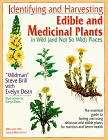|
|
 Identifying and Harvesting Edible and Medicinal Plants in
Wild (and Not So Wild) Places Identifying and Harvesting Edible and Medicinal Plants in
Wild (and Not So Wild) PlacesChapter 1: INTRODUCTION
(book excerpt)
By "Wildman" Steve Brill
There are hundreds of fascinating, delicious wild
vegetables, fruits, nuts, and seeds, and herbs growing
in our neighborhoods, backyards, parks and forests that
we overlook and disregard. Many are easy-to-recognize
renewable resources you can easily collect and enjoy,
with no harm to the environment. Many are the same
prolific "weeds" we unsuccessfully try to destroy.
When you know what they are and begin to use them,
you’ll discover that they are tastier, as well as more
nutritious, than anything you can buy, and they’re
completely free.
This book is will introduce you to the world of foraging
and nature. We cover the most common, useful wild
plants of the continental United States (with the
exception of subtropical Florida, which has a different,
specialized flora) and Southern Canada, with the basics
of what you need to know to identify, collect, use, and
appreciate them. My years as a naturalist draw on
pertinent science, nutrition, folklore, and personal
experiences to put the plants in context.
Since our focus is on the best, most practical, common,
and widespread wild edible plants, many species you
may find in other field guides are omitted. Wildflower,
tree, and mushroom field guides in the bibliography
that will help you to identify a wide range of non-edible
and marginally useful species. This book covers the
choice edible species in full detail.
Many marginally edible plants just aren’t worth your
effort: I’ve waded through frigid, muddy ponds to
collect the tender, young, unfolding leaves of water
lilies (Nymphaea species) After washing off the mud,
cooking them, and serving them for dinner, I
discovered that this "vegetable" tastes just like the mud
it grows in. Later on, I found that some of my field
walk participants, inspired by other sources, had similar
experiences.
I once dried the leaves of skunk cabbage
(Symplocarpus foetidus) in my food dehydrator for a
week, again following recommendations elsewhere,
then added them to a pot of chili. Chili should be hot,
but this brew was something else. After tasting one
spoonful, the calcium oxalate crystals that should have
been dissipated by drying began piercing my tongue,
like thousands of microscopic needles. After half an
hour of drinking and spitting out water, jumping up and
down, and cursing the author, I flushed the entire
concoction down the toilet. Subsequently, a friend
rendered this plant harmless by drying it for six
months, but then it tasted like paper. This plant, and
edibles that require hours of preparation for a few
bites, are omitted.
I've been using many plants for food and home
remedies since the late 1970’s, and I’d like to share my
favorites with you. However it’s beyond the scope of
this book to cover the thousands of purely medicinal,
non-edible plants that also grow in our midst. We
concentrate only on the delicious wild foods you can
sink your teeth into. Also, we don’t cover mushrooms,
because you’d need a whole book do them justice.
Fortunately, there are many wonderful mushroom
books on the market.
Most works on edible wild plants include recipes where
healthful wild plants are adulterated with refined and
processed foods containing artificial chemicals. It's easy
to make fantastic-tasting, nutritious meals without any
of these. A large portion of this book is devoted to
recipes and the ideas behind them, so you’ll learn to
create all-natural wild meals yourself.
This book includes many detailed pencil drawings that
clarify the plants’ identifying characteristics, and all
their parts, as they appear throughout the seasons.
Beginners seek out color photos, but these have
disadvantages: Because leaves are green, and flower
colors can be described, color mainly raises a book’s
price. This limits you to one view per plant, usually
when it’s in flower, even when different stages are
edible. Photos also contain extraneous details absent in
good illustrations. You’ll learn more from the greater
number of excellent pencil illustrations we provide.
________________________________________________
Click here to visit Steve's Web Site |
